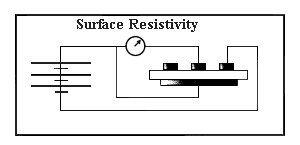Surface Resistivity Testing of Plastics
The surface resistance of a plastic is, as the name suggests, the resistance to the flow of electrical current across its surface. This is in contrast to the volume resistivity (or simply electrical resistivity), which is the resistance to flow through the three-dimensional volume of a sample. The common test in the USA is ASTM D257; other test methods include IEC 93 - IEC 60093 and JIS K6911. The figure below, from Mitsubishi Chemical Advanced Materials, illustrates the test geometry.
 ASTM D257:The resistance to an electrical current is measured by electrodes on the same surface. Side view; the top inner electrode and the bottom (ground) are circular while the outer top electrode is annular. Results are reported in ohms.
ASTM D257:The resistance to an electrical current is measured by electrodes on the same surface. Side view; the top inner electrode and the bottom (ground) are circular while the outer top electrode is annular. Results are reported in ohms.
Control of environmental factors is important because the surface resistivity of a polymer can change rapidly in response to humidity changes. A thorough reporting of test results for moisture-sensitive polymers includes the temperature and humidity of the sample before and during the measurement.
Low surface resistivity is important in applications where static electricity dissipation is required. Engineering plastics are inherently very good insulators with surface resistance values typically in the range 1014 to 1018 ohm in base resins. Decreased resisitivity (increased conductivity) is often imparted to plastics by additives such as conductive carbon fibers/carbon black or by surface treatment of finished products. Bulk additives are preferred where permanence is a concern. The upper limit for surface resistivity of a polymer considered to be considered 'static controlled' is about 1012 ohm.
The surface resistivity of metals is almost never measured because of their inherently high conductivity - static buildup is not a problem on bare metal surfaces - although the electrical resistivity through the volume of metals is an important property measurement for many applications.
